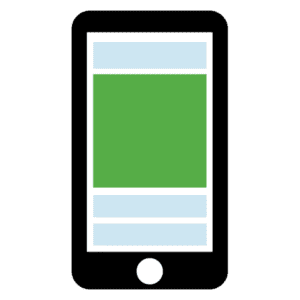If you’ve never made a purchase on your mobile device, you are in the minority. More than 77% of Americans owned a smartphone by the end of 2018, and of those people, 79% have made a purchase from their mobile devices. Whether it’s reading news on The New York Times app, pulling out your iPhone to Google “closest lunch spots,” or opening Instagram in hopes of finding something to buy, mobile use is becoming nothing less than a habit for most consumers. And this means they’re seeing tons of mobile ads.
Smartphones are changing the game across industries, and ecommerce is no exception – in fact, it’s the rule. More than half of all internet shopping in 2018 was done from a mobile device, and that number is rapidly increasing.
How Does This Relate to Facebook Advertising?
In the social media world, mobile device use is the standard, with 96% of Facebook users and 100% of Instagram users accessing the platforms on mobile. In the same way that businesses need to optimize websites for the small screens on smartphones, it’s critical to optimize your Facebook and Instagram ads for mobile, as well.
When optimizing mobile ads, advertisers should keep three things in mind: screen size, nativeness, and elimination of friction points.
1. Screen Size
Mobile screens are much smaller than desktop, laptop, and even tablet screens, with the iPhone X measuring 6.5 inches and the largest Samsung Galaxy measuring 6.8 inches. With a screen this small, standard Feed placement ads will look much smaller, and text overlay that shows clearly on a desktop or laptop will be difficult to read.
2. Nativeness
Users crave authentic, engaging visuals on most social media platforms. This is especially true on Instagram, which is an entirely visual platform. When an Instagram user scrolls through the Feed or Stories, an ad should not feel like an interruption, but rather another visually appealing post that inspires engagement.
3. Elimination of Friction Points
More than half of all traffic comes from mobile devices, but it takes an average of 15 seconds for mobile sites to load. Since the average user waits three seconds for a site to load before giving up, this quick load time is considered a friction point – a hiccup someone encounters when journeying from an ad click to an online purchase. Friction points are an e-commerce brand’s worst enemy.
What Are the Solutions?
Facebook and Instagram have multiple solutions available to advertisers, including mobile-friendly ad placements and creative formats.
Stories
With more space and fewer distractions, Stories ads show up in the Stories section of Instagram and Facebook. Instagram Stories specifically are the fastest growing ad placement due to increased use of the feature – 500 million people use Instagram Stories every day.
Stories ads take up the entire screen, maximizing creative real estate and clearly conveying your brand’s message through images or video. When using properly optimized creative that’s authentic, visually appealing and vertical, a Stories ad is the most native ad placement available.
Collections
Collection ads are available on Facebook and Instagram and are the equivalent of window shopping in ad form.
Collection mobile ads open up to a full screen experience, or Canvas, instead of a website, which eliminates the friction point between clicking the ad and product discovery. The Canvas features products from an advertiser’s catalog, which can be manually curated or dynamically filled in by Facebook.
Since the user has to jump through fewer obstacles to browse products from your catalog, there’s a higher chance they will discover a product they like, or make it to the final step: a purchase.
Dynamic Ads for Stories
Those who are familiar with Dynamic Product Ads understand the power of the ad format – since the mobile ads rely on product views, add-to-carts, and matched product IDs from a catalog, the ads are capable of the highest intent level of retargeting. Until recently, this highly profitable ad type was not available on Stories placements, but as of Spring 2019, it is.
This feature is brand new and there is not enough testing to measure the success of the format in Stories, but marrying the most profitable ad format with the fastest growing ad placement will most likely bring strong results.
So, What About Your Feeds Ads?
In 2018, Facebook announced its official creative “best practice” for single image/video Feed ads: Using square images instead of wide images. Square images take up more screen space on mobile, bringing better results for square ads.
Want to beef up your social media advertising game even more? Check out some of our resources below!




